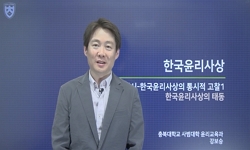본고는 조선전기 선비라는 주제로 그들이 추구한 유교적 이상사회에 대해 검토하였다. 일반적으로 조선시대 선비라고 하면 여말선초의 사대부라 할 수 있는데, 이들은 조선왕조 개국을 둘...
http://chineseinput.net/에서 pinyin(병음)방식으로 중국어를 변환할 수 있습니다.
변환된 중국어를 복사하여 사용하시면 됩니다.
- 中文 을 입력하시려면 zhongwen을 입력하시고 space를누르시면됩니다.
- 北京 을 입력하시려면 beijing을 입력하시고 space를 누르시면 됩니다.
https://www.riss.kr/link?id=A100387615
- 저자
- 발행기관
- 학술지명
- 권호사항
-
발행연도
2015
-
작성언어
Korean
-
주제어
Jo Gwangjo ; 조광조 ; 趙光祖 ; Toegye ; 퇴계 ; 退溪 ; Hayang Heossi ; 하양허씨 ; 河陽許氏 ; Dongbangohyeon ; 동방오현 ; 東方五賢 ; Munmyojongsa ; 문묘종사 ; 文廟從祀
-
등재정보
구)KCI등재(통합)
-
자료형태
학술저널
-
수록면
45-82(38쪽)
- 제공처
- 소장기관
-
0
상세조회 -
0
다운로드
부가정보
국문 초록 (Abstract)
본고는 조선전기 선비라는 주제로 그들이 추구한 유교적 이상사회에 대해 검토하였다. 일반적으로 조선시대 선비라고 하면 여말선초의 사대부라 할 수 있는데, 이들은 조선왕조 개국을 둘러싸고 관학파와 사학파로 이후 세조정변을 계기로 훈구파와 사림파로 나누어지게 되는데, 본고의 주제인 선비의 모습은 16세기 집권 훈구세력에 대한 비판세력으로서의 사림파에서 더 선명하게 나타난다. 이 시기 사림세력은 집권세력과 다른 몇 가지 특징이 있는데, 그 핵심은 (1) 정치적으로는 유교적인 이상국가 건설을 위한 도학정치를 추구하였으며, 이것이 본격적으로 제기된 것은 조광조부터이다. (2) 향촌의 재지적 기반 위에서 학문활동이 이루어졌다는 점에서 鄕黨的 색채를 강하게 띠고 있다. 이들의 향촌문제에 대한 관심은, 종래의 고려조적인 佛敎的이고 淫祀的인 吏族중심의 향촌사회를 士族 중심의 유교적인 향촌질서체제로 재편하고자 하였다. 이를 위해 『朱子家禮』『小學』鄕射禮.鄕飮酒禮 등 성리학적 실천윤리의 보급을 위한 유향소 복립운동, 나아가 향약·서원보급 운동을 전개하였다. (3) 성리학적 대의명분으로 節義사상을 계승 실천하였고 (4) 집권의 명분 강화를 위한 학문적 정통성 강화를 위한 문묘종사 운동을 추진하였다. 본 논문에서는 이러한 이 시기 사림세력을 특징지울 수 있는 위 4가지를 중심으로 정리한 것이다.
다국어 초록 (Multilingual Abstract)
The topic of this study is seonbi during early Chosun and is going to look into Confucian ideal society that they pursued then. The seonbi in Chosun generally refers to the sadaebu during late Goryeo and early Chosun. Concerning the foundation of Chos...
The topic of this study is seonbi during early Chosun and is going to look into Confucian ideal society that they pursued then. The seonbi in Chosun generally refers to the sadaebu during late Goryeo and early Chosun. Concerning the foundation of Chosun Dynasty, they were divided into Gwanhakpa and Sahakpa, and then, after the Sejojeongbyeon, they were separated into Hungupa and Sarimpa. The aspects of seonbi, the topic of this paper, are more distinctly found in Sarimpa as the force criticizing the hungu force that ruled in the 16th century. In this period, the sarim force exhibited several characteristics differently from the ruling power. The key points are that (1) they pursued Dohak politics to found a politically Confucian ideal state, and this was genuinely started from Jo Gwangjo. (2) In the point that the academic activities were done on the residing ground of hyangchon, they were strongly characterized by the color of hangdang(鄕黨). Their major concern over the matters of hyangchon was to reorganize the previous Goryeo’s ijok(吏族)-centered hyangchon society that was based on Buddhism and eumsa(淫祀) into the Confucian system of hyangchon order centered around sajok(士族). For this, they developed the Yuhangso Restoration Movement and also Hyangyak·Seowon Distribution Movement in order to spread practical, new-Confucian ethics including 『Jujagarye (朱子家禮)』, 『Sohak(小學)』, Hyangsarye(鄕射禮), or Hyangeumjurye(鄕飮酒禮). (3) They transmitted and practiced the notion of Jeolui(節義) as the pretext of new-Confucianism. (4) They also promoted the Munmyojongsa Movement to solidify their academic legitimacy to justify their reign. This study has arranged the aspects of the sarim force in that period with the four characteristics above.
동일학술지(권/호) 다른 논문
-
기획논문 : 선비들의 임란 창의정신(倡義精神)과 의병 활동
- 경북대학교 퇴계연구소
- 우인수 ( Woo In Soo )
- 2015
- 구)KCI등재(통합)
-
- 경북대학교 퇴계연구소
- 박희택 ( Park Hee Taek )
- 2015
- 구)KCI등재(통합)
-
- 경북대학교 퇴계연구소
- 김미영 ( Kim Mi Young )
- 2015
- 구)KCI등재(통합)
-
투고논문 : 회연서원(檜淵書院)의 입지환경(立地環境)과 풍수논리(風水論理)
- 경북대학교 퇴계연구소
- 박정해 ( Park Jeong Hae )
- 2015
- 구)KCI등재(통합)




 KISS
KISS



